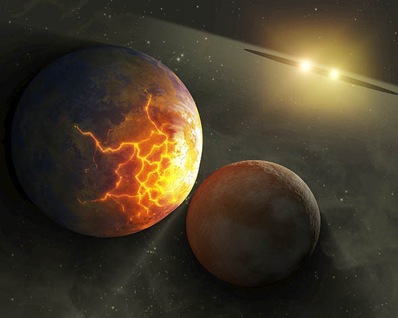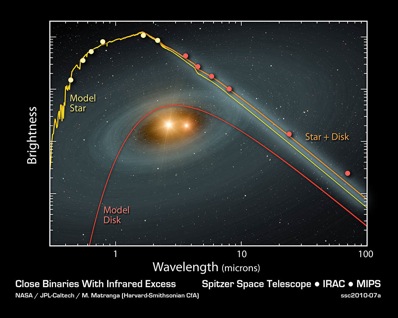
Dusty double stars aftermath of planetary collisions
DR EMILY BALDWIN
ASTRONOMY NOW
Posted: 25 August 2010


Large amounts of dust observed around closely orbiting stellar pairs by NASA's Spitzer Space Telescope suggest that the systems' planets may have met a violent fate.

Artist impression of an imminent planetary collision around a pair of double stars. Collisions like this are likely responsible for the excess dust observed in mature binary systems. Image: Spitzer/JPL.
One of the systems probed by Spitzer was double star RS Canum Venaticorums (or RS CVns), which is separated by just 3.2 million kilometres – just two percent the distance between the Earth and Sun. Although the stars are similar in size to the our Sun they spin much faster, and orbit around each other every few days with one face permanently locked towards towards the other.
Their rapid rotation whips up powerful magnetic fields that drive strong stellar winds. This results in a net slowing down of the stars' rotation, pulling them closer together over time. This is the likely trigger for the ensuing planetary turmoil; the changing gravitational influence inflicting disturbances throughout the system. Not only would neighbouring planets be subject to collisions with each other, but the star's habitable zone – a region where liquid water is stable on a planet – may suddenly shift.

Spitzer observed the signatures of dust around three close binary systems. Data for one of those systems are shown here in orange. Models for the stars and a surrounding dusty disc are shown in yellow and red, respectively. The data suggests that a chaotic event such as a planetary collision must have generated the dusty disc. Image: NASA/JPL-Caltech/M. Matranga (Harvard-Smithsonian CfA).
“These kinds of systems paint a picture of the late stages in the lives of planetary systems,” says Marc Kuchner from NASA's Goddard Space Flight Center. “And it’s a future that’s messy and violent.”
The systems were detected thanks to the infrared glow of the hot dusty discs circling three tight binary systems. Normally, this dust would have been swept away by the stellar winds of such mature stars, so another process must be replenishing the dust. Collisions between planetary bodies seem the most likely solution, and the fact that these dusty discs have been spotted around a number of mature binary systems suggests that these observations are not a one-off.
“This is real-life science fiction,” comments Jeremy Drake of the Harvard-Smithsonian Center for Astrophysics. “It’s theoretically possible that habitable planets could exist around these types of stars, so if there happened to be any life there, it could be doomed.”
|



